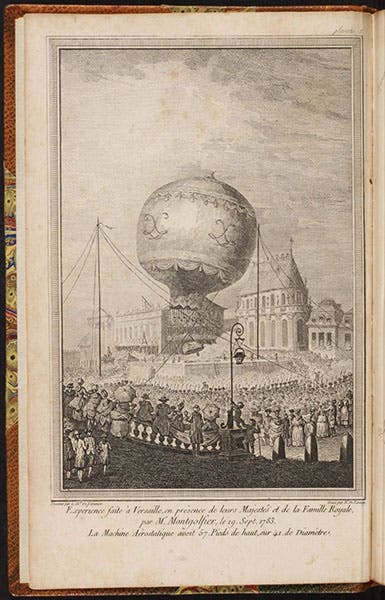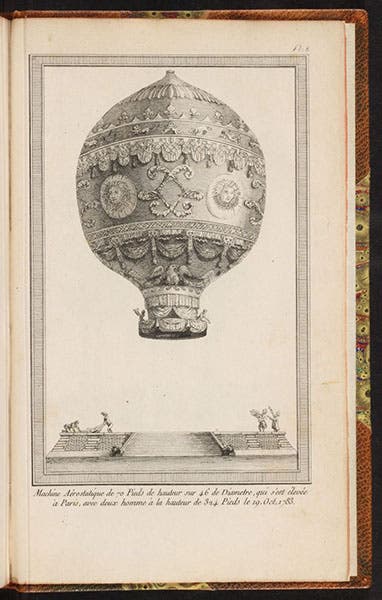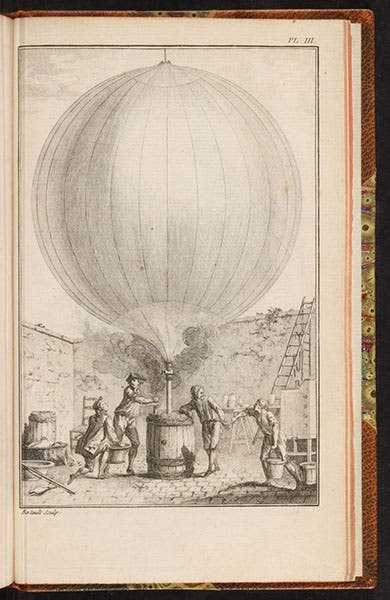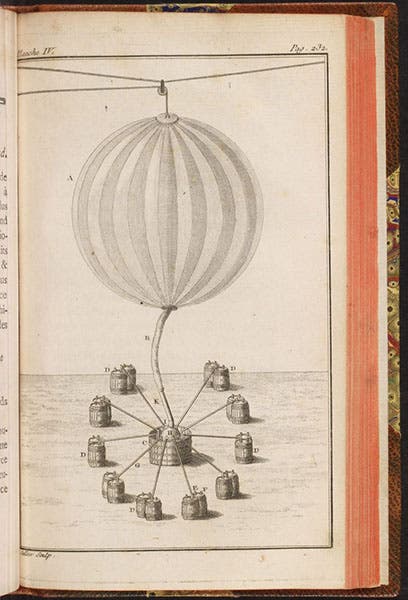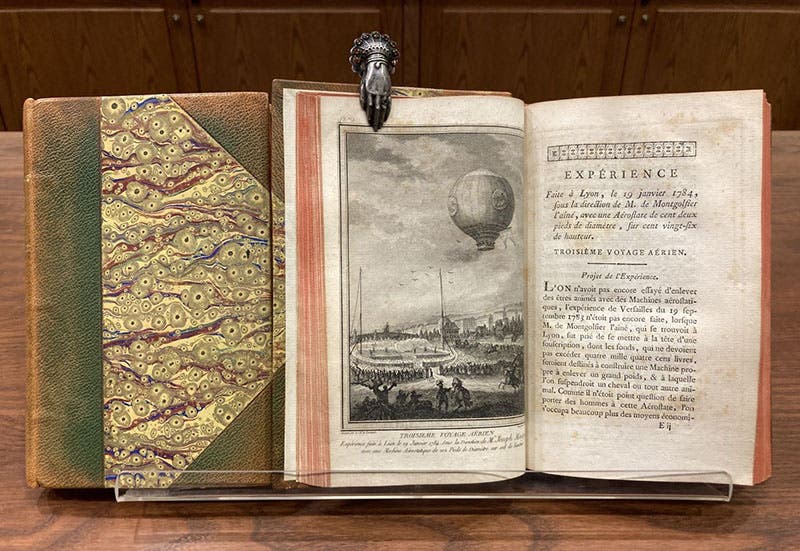Scientist of the Day - Barthélemy Faujas-de-Saint-Fond
Barthélemy Faujas-de-Saint-Fond, a French geologist, paleontologist, and scientific traveler, died July 18, 1819, at age 78. Faujas wrote a large folio on the extinct volcanoes of central France, which we included in our 2004 exhibition, Vulcan’s Forge, and an equally large folio about a fossil found in Maastricht, Holland, which Faujas thought was a crocodile, but was later shown to be an extinct mosasaur, and which we displayed in our 2009 exhibition, The Grandeur of Life.
Today we feature something different. In 1783, all of Paris was abuzz with preparations by the Montgolfier brothers, Joseph-Michel and Jacques-Étienne, to attempt the first successful flight of a manned hot-air balloon, and Faujas was right in the middle of the fervor, publishing the very first account of the earliest attempts, Description des expériences de la machine aérostatique de MM. de Montgolfier, in two volumes (1783-84).
The first volume described the first ascent of a Montgolfier brothers balloon on Sep. 19, 1783, a dramatic affair in which the passengers were a rooster, a sheep, and a duck (first image). This launch took place at Versailles.
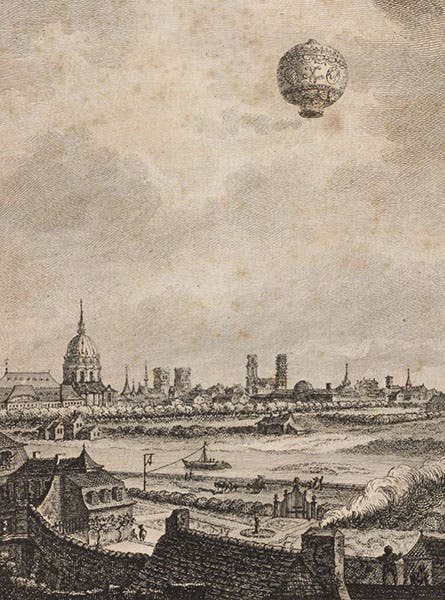
First free ascent of a manned hot-air Montgolfier balloon, Nov. 21, 1783, with Pilâtre de Rozier and Francois d’Arlandes on board, detail of engraved frontispiece, in Description des expériences de la machine aérostatique de MM. de Montgolfier, by Barthélemy Faujas-de-Saint-Fond, vol. 2, 1783-84 (Linda Hall Library)
Faujas also provided a close-up view of the wallpaper skin of a balloon that was used for an Oct. 19 tethered ascent (second image), and illustrated the filling of a hydrogen balloon for Jacques-Alexandre Charles (third image), a dangerous procedure that generated hydrogen by pouring sulfuric acid into a barrel of iron nails.
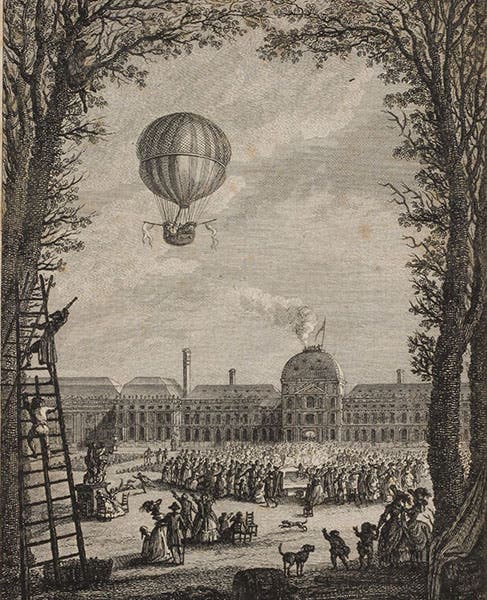
Ascent of the first hydrogen balloon on Dec. 1, 1783, with Jacques Charles and the younger Robert brother in the basket, detail of engraving in Description des expériences de la machine aérostatique de MM. de Montgolfier, by Barthélemy Faujas-de-Saint-Fond, vol. 2, plate 3, p. 31, 1783-84 (Linda Hall Library)
The second volume described and illustrated the first manned ascent of Nov. 21, 1783, with Pilâtre de Rozier and Francois d’Arlandes on board (fourth image) and the first manned ascent of a hydrogen balloon on Dec. 1 (fifth image), with Jacques Charles and a passenger known only as “the younger Robert brother” in the basket.
Faujas also depicted a new and improved way of filling a hydrogen balloon, using 10 double-barrels instead of one, and moving the red-hot, acid-filled barrels away from the vicinity of the balloon fabric, but it does not seem that much safer to me (sixth image).
We also show the title page of volume 1 of our set (seventh image), because, even though it is a less striking image, the title page is your assurance that the other images shown are originals, from the first edition of the book.
The engravings in some copies of Faujas’ Description are colored, which makes the balloons especially dramatic, but our uncolored copy is in beautiful condition, with half-morocco / half marbled-paper boards (eighth image), and we are happy to have it.
NOTE: This post was originally published on May 17, 2018. During one of the migrations from server to server, it disappeared and has resisted recovery. So we publish it again today, slightly revised, and with complete captions, which the original post lacked. Since its original appearance, we have published two more posts on Faujas, one on his book on the volcanoes of southeastern France, and another on his encounter with William and Caroline Herschel. A fourth post, about his discovery of a mosasaur skull in the Netherlands, has also disappeared, and we will be reposting that one in the near future. When it has been reinstalled, you will find it here.
William B. Ashworth, Jr., Consultant for the History of Science, Linda Hall Library and Associate Professor emeritus, Department of History, University of Missouri-Kansas City. Comments or corrections are welcome; please direct to ashworthw@umkc.edu.


